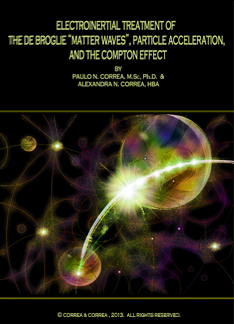![Akronos logo]](/images/akronos_wheel.jpg)
|
Akronos Publishing Concord, ON, Canada www.aetherometry.com |
![Akronos logo]](/images/akronos_wheel.jpg)
|
Akronos Publishing Concord, ON, Canada www.aetherometry.com |

Electroinertial Treatment of
the de Broglie 'Matter-Waves', Particle Acceleration,
and the Compton Effect
by Correa, Paulo N. & Correa, Alexandra N.
Published in August 2013. 89 pages.
Aetherometric Theory of Synchronicity, Vol. 3
Monograph AS3-III.8
Price: (ISFA only) US $40
This monograph is available exclusively to ISFA members, or by special arrangement.
|
ABSTRACT
We propose an electroinertial analysis of particle acceleration, tested with electrons or beta particles, that makes superfluous the relativistic contention of mass increase with acceleration as explanation for the asymptotic behavior of linear speed in the range of subluminal values. Likewise, the hypothesis of a magnetic brake is also tested and found not to be satisfying. Instead, we propose an electric brake sourced in the limitation that the mass-energy of a charge-carrier imposes upon the kinetic energy of the charge, as the very condition for the conservation of its mass and inertia, and which operates at the level of the electric (voltage) wave of that kinetic energy. Charge and mass are both found to be conserved. With this new method, the Bertozzi experiment and variants, as well as the Kauffmann-Bucherer beta decay experiments, are re-analyzed. New algebra is provided that treats this electric brake without recourse to any relativistic transformations, while matching the empirical data more closely than Special Relativity. Essentially, above a minimum limit found to lie at 284 keV, the kinetic energy and voltage increasingly ("asymptotically") diverge from the applied field input energy and voltage, up to a limit de Broglie wavelength given by the Compton-electron wavelength. Similarly, the de Broglie total energy of the accelerated particle is found to have half this wavelength as its limit. The implications of this analysis for the "elastic interaction" of an X-ray photon and an electron in Compton scattering are brought out: foremost amongst them are the demonstration that Compton scattering depends upon the de Broglie total energy of the accelerated particle, and its corresponding wavelength; that the re-emitted (outgoing) X-ray photon also has an energy and a wavelength limit, and that the lowest limit wavelength of the outgoing X-ray photons occurs with an incoming X-ray energy just shy of 1.022 MeV: λ'mean0-180 = λBT + λ = 0.012Å + 0.012Å ≈ λceBelow or beyond the 0.012Å limit, and in full accordance with empirical data regarding X-ray absorption, any incoming X-ray "colliding" with an electron will generate a lepton and a "recoiling" nanoatom of dipositronium which will collapse into a gamma ray. For anticathode X-ray production by accelerated electrons, the same process of physical limitation of kinetic energy places a maximum X-ray energy at 511 keV, with a minimum wavelength given by λmin = λce = λpminin full conformity with the Duane-Hunt law. |